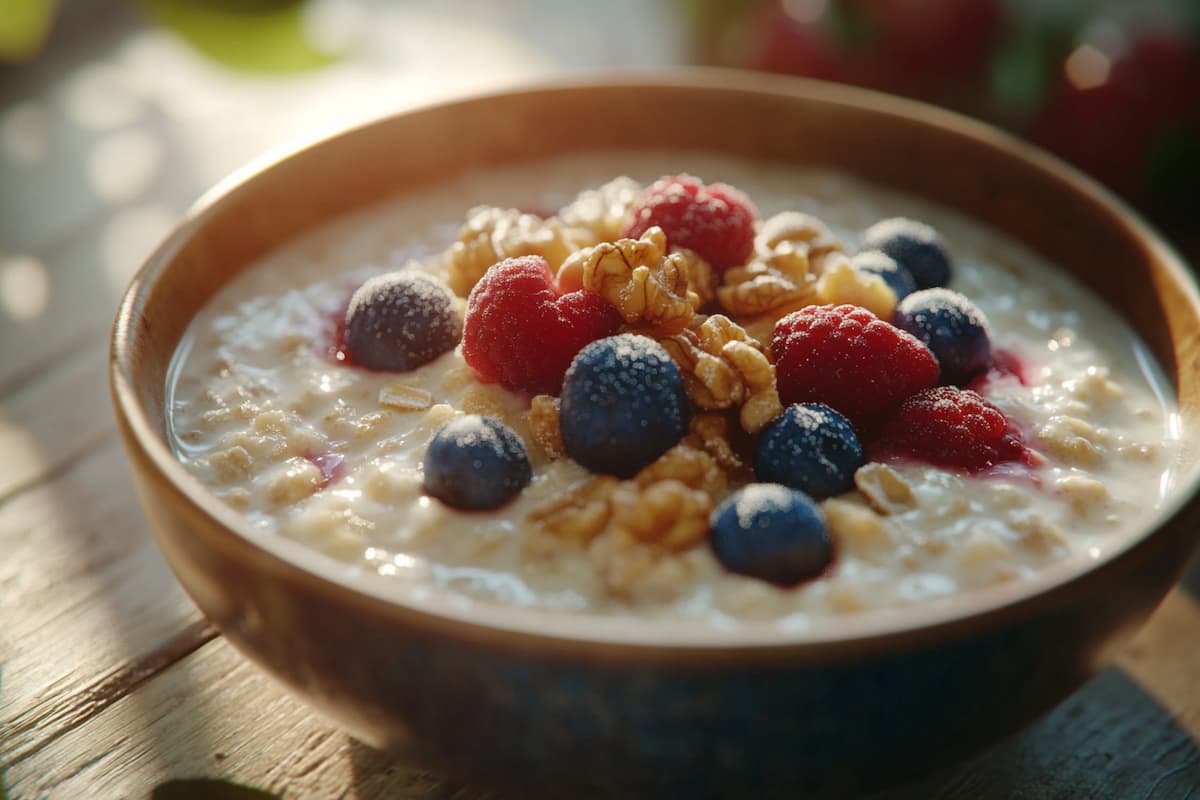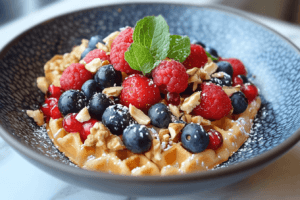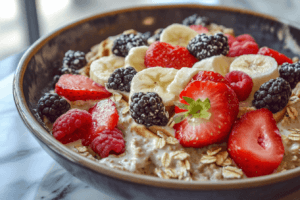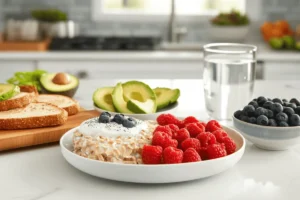Many people ask, What are 5 healthy breakfasts? because they want an easy way to start their day feeling great. The first meal of the day plays an essential role in improving mood, supporting digestion, and maintaining stable energy. However, choosing the right combination of ingredients can feel overwhelming if you are unsure where to begin.
However, simply picking random foods is not enough. You need synergy among nutrients to create lasting fullness, stable blood sugar, and a steady flow of energy. For example, pairing whole grains with protein and healthy fats reduces mid-morning cravings. In addition, adding colorful fruits and vegetables boosts fiber and antioxidants. Therefore, by selecting the right foods, you create a morning routine that supports your body and mind.
Table of Contents
Why a Healthy Breakfast Matters
A healthy breakfast sets the tone for your day. Eating a balanced meal within a few hours of waking supports stable mood and productivity. Therefore, choosing the right nutrients can improve your focus, reduce stress, and promote better decision-making. In addition, a nutritious morning meal can help prevent energy crashes later on.
Many people skip breakfast due to time constraints or lack of appetite. However, including at least one balanced option can improve metabolic function. For example, a simple bowl of oatmeal with fruits and nuts takes only minutes to prepare. By doing so, you start your day with a steady supply of energy rather than reaching for sugary snacks mid-morning.
Moreover, eating a nutrient-dense breakfast daily helps form lasting habits. Over time, consistent morning meals lead to better overall eating patterns. Eventually, these choices influence long-term health outcomes, from weight management to improved digestion. Thus, a balanced breakfast is a small investment that yields significant returns.
The Key Nutrients for a Balanced Breakfast
Before exploring What are 5 healthy breakfasts? let’s understand which nutrients matter most. A satisfying breakfast often contains protein, fiber, healthy fats, and complex carbohydrates. This combination supports fullness, stable blood sugar, and a positive mood.
- Protein:
Protein maintains muscle, supports immune health, and promotes fullness. Lean proteins like Greek yogurt, eggs, tofu, or smoked salmon help keep cravings at bay. - Fiber:
Fiber slows digestion, stabilizes blood sugar, and promotes gut health. Whole grains, fruits, vegetables, and seeds offer ample fiber. - Healthy Fats:
Fats improve nutrient absorption and prolong satiety. Sources include avocado, nut butter, seeds, and nuts. Even a small serving of healthy fats can enhance flavor and texture. - Complex Carbohydrates:
Whole grains, oatmeal, quinoa, and sweet potatoes provide long-lasting energy. These carbs digest slowly, preventing energy dips or sudden hunger.
By mixing these nutrients, you create a breakfast that energizes and satisfies. Therefore, consider these factors as we delve into What are 5 healthy breakfasts? that you can try.
What are 5 healthy breakfasts? Let’s Break It Down
Now that we’ve covered the basics, let’s answer the main question: What are 5 healthy breakfasts? We will detail five options, each featuring balanced nutrients and easy preparation methods.
1. Creamy Oatmeal with Berries and Nuts
Oatmeal remains a breakfast classic for good reason. It’s rich in fiber, versatile, and comforting. Start with plain oats rather than sugary instant versions. Therefore, you control added sweetness and maximize nutrition.
How to Make It:
- Simmer rolled oats in water or almond milk until creamy.
- Top with fresh or frozen berries for antioxidants and natural sweetness.
- Sprinkle chopped walnuts or almonds for protein, healthy fats, and crunch.
- Add a pinch of cinnamon for flavor depth.
Why It’s Healthy:
Oats contain beta-glucan, a type of soluble fiber that supports heart health. Berries add vitamins and antioxidants, while nuts supply healthy fats and protein. In addition, this combination keeps you full longer, reducing midday snacking. For an extra protein boost, stir in a spoonful of Greek yogurt.
2. Greek Yogurt Parfait with Seeds and Honey
Greek yogurt is high in protein and creamy in texture. Pair it with fruits, seeds, and a drizzle of honey for a quick, no-cook option. Therefore, you enjoy a simple meal that’s both portable and nourishing.
How to Make It:
- Spoon Greek yogurt into a bowl or jar.
- Add a layer of mixed berries or diced peaches.
- Sprinkle chia or flax seeds for fiber and omega-3 fatty acids.
- Drizzle a small amount of honey for natural sweetness.
Why It’s Healthy:
Greek yogurt provides substantial protein, supporting muscle maintenance and fullness. Seeds offer fiber and healthy fats, while fruit contributes vitamins and natural sweetness. For those avoiding dairy, choose a plant-based yogurt made from almonds or coconut. This parfait requires no cooking and can be prepped the night before for busy mornings.
3. Veggie Omelet with Avocado and Whole-Grain Toast
Eggs deliver high-quality protein, and veggies supply fiber, vitamins, and minerals. Adding avocado provides healthy fats, while whole-grain toast offers complex carbohydrates. Therefore, this meal checks all the boxes for a balanced breakfast.
How to Make It:
- Whisk eggs in a bowl with a pinch of salt and pepper.
- Sauté spinach, mushrooms, and cherry tomatoes in a nonstick skillet.
- Pour in the eggs and let them cook until set.
- Fold the omelet, top with sliced avocado, and serve with whole-grain toast.
Why It’s Healthy:
Eggs contain essential amino acids and help keep you full. Vegetables add fiber, antioxidants, and color to your plate. Avocado supports heart health and boosts nutrient absorption. Whole-grain toast provides steady energy. This combination makes a savory, satisfying meal that sustains energy throughout the morning. For a lactose-free version, skip the cheese or use a dairy-free option.

4. Quinoa Breakfast Bowl with Nuts, Seeds, and Fruit
Quinoa, a gluten-free pseudo-grain, is rich in protein and minerals. It cooks quickly and pairs well with sweet or savory ingredients. Turning quinoa into a breakfast bowl adds variety to your routine, especially if you’re bored with oats.
How to Make It:
- Cook quinoa according to package instructions.
- Stir in almond milk or oat milk for creaminess.
- Top with sliced banana, chopped walnuts, and pumpkin seeds.
- Add a spoonful of almond butter or sunflower seed butter for richness.
Why It’s Healthy:
Quinoa contains all nine essential amino acids, making it a complete protein. Nuts and seeds add crunch, healthy fats, and fiber. Fruit provides natural sweetness and vitamins. Together, these ingredients create a nutrient-dense meal that stabilizes blood sugar and keeps you satisfied. For a boost of flavor, sprinkle cinnamon or cocoa nibs on top.
5. Green Smoothie with Spinach, Almond Butter, and Berries
Smoothies offer a quick, portable option when you’re pressed for time. By choosing the right ingredients, you ensure a balanced blend of protein, fiber, and healthy fats. Therefore, smoothies become a powerful tool for busy mornings.
How to Make It:
- Start with a handful of fresh spinach for fiber and iron.
- Add frozen berries for antioxidants and sweetness.
- Spoon in almond butter or peanut butter for protein and healthy fats.
- Pour in almond milk or soy milk and blend until smooth.
Why It’s Healthy:
This smoothie includes leafy greens, antioxidant-rich berries, plant-based protein, and healthy fats. It digests easily and keeps you full. Add a scoop of protein powder for extra protein if desired. Smoothies also allow endless variations. For example, swap spinach for kale, or use mango instead of berries for a tropical twist.
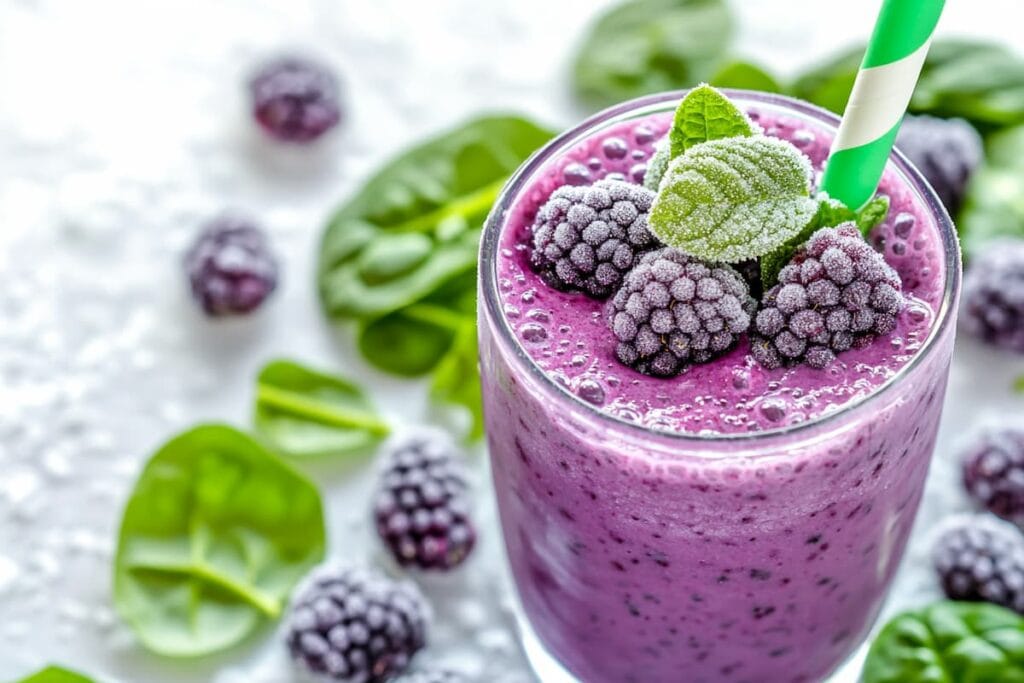
Tips to Maintain a Healthy Breakfast Routine
Now that you know What are 5 healthy breakfasts? consider strategies to maintain consistency. Preparing ingredients in advance helps reduce morning stress. For example, chop fruit the night before or pre-measure oats and seeds. By doing so, you save time and prevent reaching for less healthy convenience foods.
In addition, rotating breakfast options keeps you motivated. Alternate between oatmeal, omelets, parfaits, quinoa bowls, and smoothies to prevent boredom. This variety ensures you receive a broad range of nutrients over time.
Moreover, consider the season. In winter, warm bowls of oatmeal or quinoa comfort the soul. In summer, cold yogurt parfaits or green smoothies offer refreshing relief. Adapting your breakfast choices to the weather maintains interest and encourages you to keep up the habit.
Overcoming Common Challenges
Some people find it hard to eat in the morning, while others struggle with time. However, simple solutions exist. If you have no appetite, start with a smaller portion, like half a cup of yogurt topped with fruit. Over time, your body may adapt and welcome the morning meal.
If time is an issue, consider preparing overnight oats or a yogurt parfait the night before. Alternatively, blend your smoothie ingredients in individual bags and store them in the freezer. In the morning, just dump and blend. These small steps reduce morning chaos and support a balanced lifestyle.
For those concerned about cost, focus on affordable staples. Oats, frozen berries, bananas, and nut butter purchased in bulk can save money. Seasonal produce also tends to be cheaper and fresher, improving both flavor and nutrition.
Adding Superfoods to Boost Nutrition
While the five breakfasts listed are already healthy, you can enhance them further. Add superfoods like chia seeds, ground flax, hemp seeds, or goji berries. These ingredients supply extra fiber, protein, and antioxidants. Therefore, a small sprinkle can increase nutrient density without much effort.
You can also experiment with spices. Cinnamon, ginger, turmeric, and cardamom add flavor depth and potential health benefits. For example, a pinch of turmeric in your oatmeal might support anti-inflammatory effects. In addition, these spices reduce the need for extra sweeteners, keeping your breakfast balanced.
Trying new superfoods and spices keeps your meals exciting. Over time, you refine your personal breakfast formula. Eventually, you develop favorites that support both health and taste preferences.
Staying Inspired and Informed
It helps to stay updated with nutrition trends and research. Follow reputable dietitians, doctors, or nutrition-focused bloggers. This approach keeps you learning about ingredients, methods, and recipes.
For further inspiration, consider exploring High-Protein Gluten-Free Breakfast Ideas on our website. In addition, if you seek variety, check out our Dairy-Free Smoothie Bowls for plant-based options. If you enjoy savory breakfasts, Healthy Avocado Toast Ideas can inspire creative toppings.
As you gain knowledge, you become more confident in experimenting. Eventually, you rely less on strict recipes and more on intuition. This flexibility makes healthy eating a natural part of your morning routine.
Considering Dietary Restrictions and Preferences
If you follow a gluten-free diet, choose certified gluten-free oats or swap oats for quinoa. For dairy-free options, use almond milk or coconut yogurt. If you avoid eggs, try a tofu scramble or a chickpea flour omelet instead. Therefore, it’s easy to adapt these breakfasts to different dietary needs.
In addition, if you prefer low-sugar options, reduce the amount of honey or maple syrup. Rely on whole fruits for sweetness. Over time, your taste buds adjust to lower sugar intake, making natural flavors stand out.
For a vegan approach, pick plant-based yogurts, milk, and protein sources. Avocado, nuts, seeds, tofu, and legumes all work well. Eventually, you find the perfect combinations that align with your values and preferences.
Sustainability and Breakfast Choices
Choosing locally grown, seasonal produce reduces transportation and often improves nutrient density. Buying oats, nuts, and seeds in bulk reduces packaging waste. Thus, making thoughtful breakfast choices can also benefit the environment.
In addition, using plant-based proteins more often can lower your carbon footprint. Smoothies with leafy greens or tofu-based scrambles reduce reliance on animal products. Small steps in your morning meal can reflect your broader commitment to sustainability.
Furthermore, proper storage methods limit food waste. Freeze ripe bananas for smoothies or turn leftover quinoa into a next-day breakfast bowl. Over time, these habits make your kitchen more efficient and eco-friendly.
Mindfulness in Eating Your Morning Meal
Rushing through breakfast can diminish enjoyment. Instead, take a few moments to savor flavors, notice textures, and appreciate colors. Mindful eating promotes better digestion and helps you recognize fullness cues.
If you struggle with rushed mornings, wake up a few minutes earlier to enjoy your meal. Alternatively, prepare your breakfast to go, but find a quiet spot at work or school to eat it. Even small moments of calm can set a positive tone for the day.
As you practice mindfulness, you may notice improvements in mood and focus. Over time, a mindful morning meal becomes a cherished ritual. This positive experience reinforces your commitment to healthy eating habits.
Involving Family and Friends
Encourage family members to try these five breakfast options. Children might enjoy decorating oatmeal bowls with colorful fruits. Partners might prefer assembling their own parfaits to match personal tastes. Therefore, making breakfast a shared experience strengthens bonds and exposes everyone to nutritious foods.
In addition, involving others fosters support and accountability. If everyone values a healthy breakfast, it becomes a household norm. Over time, these traditions shape long-term habits and improve the collective health of your family.
If you live alone, consider sharing recipes with friends or colleagues. Exchange tips or sample each other’s creations. This communal approach to healthy eating motivates you to keep exploring and improving.
Incorporating Physical Activity
A nutritious breakfast pairs well with light morning activity. Consider a short walk, gentle stretch, or quick yoga session before eating. Physical activity boosts blood flow, enhances mood, and may heighten your appetite for wholesome foods.
For example, a brief walk outside can help clear your mind and connect you to nature. Returning home to a Greek yogurt parfait or an omelet feels more rewarding after some movement. Eventually, combining exercise with a balanced breakfast sets a positive health-focused tone.
Even if you have limited time, a few minutes of stretching can improve circulation and posture. Over time, these small changes create a healthier, more energetic start to your day.
Storing and Reusing Leftovers
If you prepare too much oatmeal or quinoa, store leftovers in airtight containers for the next day. Reheat with a splash of milk and add fresh toppings. Thus, you reduce food waste and save time on subsequent mornings.
Chia puddings or overnight oats stay fresh in the refrigerator for a couple of days. Prepare multiple jars in advance and enjoy them throughout the week. This method ensures that a healthy breakfast is always ready, even when life gets hectic.
Storing seeds, nuts, and dried fruit in separate containers allows you to mix and match toppings. Keep them fresh and accessible, so you can quickly add them to any base. Over time, you’ll find that meal prep becomes an effortless part of your routine.
Embracing Seasonal Changes in Your Breakfast Menu
As seasons change, so do produce offerings:
- In spring, add fresh strawberries to your oatmeal
- In summer, try peaches in your parfait.
- In fall, mix pumpkin puree into your quinoa bowl.
- In winter, rely on frozen berries and hearty grains.
These seasonal variations ensure that you never tire of your breakfast staples. Adapting to seasonal produce also supports local farmers and enhances the nutritional quality of your meals. Thus, you continue exploring new flavors and textures all year long.
Eventually, you’ll have a mental catalog of what’s in season, making shopping and meal planning more intuitive. With each season, your breakfasts evolve, keeping your taste buds engaged.
Keeping Track of Your Progress
Consider keeping a simple breakfast journal. Note how you feel after each meal and which options keep you satisfied the longest. Tracking your reactions helps you fine-tune portion sizes, ingredients, and preparation methods.
Over time, you’ll notice patterns. Perhaps oatmeal sustains your energy best on workout days, while Greek yogurt parfait suits hectic mornings. This self-awareness guides you toward the most effective choices.
Additionally, celebrate small victories. If you’ve managed to eat a balanced breakfast every day for a week, acknowledge your success. Positive reinforcement encourages you to maintain healthy habits long-term.
Exploring International Breakfast Ideas
Global cuisines offer endless breakfast inspiration. A Japanese breakfast might feature miso soup, fish, and rice. A Middle Eastern breakfast could include hummus, olives, and cucumbers. A Latin American breakfast might incorporate corn tortillas, beans, and avocado.
These global flavors inspire new combinations of proteins, healthy fats, and complex carbs. Experimenting with international dishes keeps your morning meals exciting. Over time, you’ll develop a more adventurous palate and gain a broader understanding of nutritious foods.
Adapt these ideas to fit your dietary needs. For example, replace bread with gluten-free options or dairy with plant-based yogurts. Thus, you draw from cultural traditions while maintaining your personal health priorities.
Balancing Breakfast with Other Meals
Remember that breakfast is only one part of your daily intake. While it sets a strong foundation, aim for balance in lunch and dinner too. Choose lean proteins, whole grains, fruits, and vegetables throughout the day.
That said, a healthy breakfast often makes it easier to make wise choices later. Starting your day strong can reduce sugar cravings, stabilize energy, and improve mood. Consequently, you’re more likely to continue eating well as the hours pass.
However, allow for occasional treats. A balanced approach means enjoying a sweet pastry now and then without guilt. By maintaining perspective, you ensure a healthy relationship with food.
Conclusion
So, What are 5 healthy breakfasts? We explored oatmeal with berries and nuts, Greek yogurt parfait, veggie omelet with avocado, quinoa bowls, and green smoothies. Each option provides a balance of protein, fiber, healthy fats, and complex carbs. Together, these nutrients support stable energy, improved mood, and long-lasting fullness.
Therefore, commit to trying these breakfasts and adjusting them to your tastes. Over time, you’ll find favorite flavors and ingredients that make you feel your best. By starting your day with a nourishing meal, you set a positive tone for the hours ahead. Eventually, you’ll view breakfast not as a chore, but as an opportunity to care for yourself and enjoy a delicious, health-supporting meal.
Frequently Asked Questions (FAQs)
What is the healthiest breakfast to eat?
The healthiest breakfast contains protein, fiber, and healthy fats. For example, oatmeal with berries and nuts, Greek yogurt with seeds and fruit, or a veggie omelet with avocado. These choices stabilize blood sugar, enhance mood, and provide lasting energy.
What is the best healthy breakfast in the morning?
The best healthy breakfast is one that fits your lifestyle, tastes, and needs. A Greek yogurt parfait with berries and seeds is quick, creamy, and high in protein. Alternatively, a green smoothie with spinach and almond butter offers portability and rich nutrients. Choose what works best for your schedule and preferences.
What is a healthy meal plan for breakfast?
A healthy meal plan for breakfast focuses on variety and balance. Rotate options like oatmeal bowls, yogurt parfaits, veggie omelets, quinoa bowls, and smoothies. Add colorful fruits, nuts, seeds, and whole grains for fiber and nutrients. This rotation prevents boredom and ensures a wide range of vitamins and minerals.
What is the quickest healthiest breakfast?
A quick and healthy breakfast could be a pre-made Greek yogurt parfait with frozen berries and chia seeds. Alternatively, blend a green smoothie with spinach, berries, and almond butter in under five minutes. Preparing ingredients in advance makes these speedy options even more convenient.

